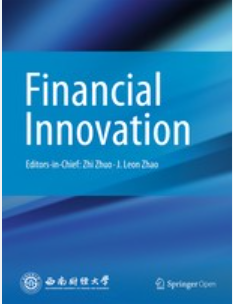尖端技术与先锋传统货币和伊斯兰加密货币之间的不对称互动:基于日内好坏波动率的新证据
IF 7.2
1区 经济学
Q1 BUSINESS, FINANCE
引用次数: 0
摘要
本研究通过量子交叉谱相干性、量子-VAR 关联性以及基于量子的非线性均值因果关系和方差分析这三种方法,研究了金融科技(FinTech)、物联网、人工智能和技术这三场技术革命以及比特币和恒星币这两大传统和伊斯兰加密货币平台的好坏波动率之间的联系。结果如下(1)在正常市场条件下,在长期视角中,金融科技的正波动率与恒星的负波动率之间存在显著的正交谱关系;(2)恒星的负波动率和正波动率分别在下尾和上尾表现出最高的净溢出效应;(3)基于量子的因果关系结果表明,比特币的好(坏)波动率会导致在正常市场和牛市条件下运行的三种智能技术的坏(好)波动率。此外,比特币行业的负波动率与金融科技行业的正波动率存在双边因果关系。通过分析第二时刻,我们发现比特币的负波动率是唯一以单向方式产生金融科技良好波动率的原因变量。至于恒星,只有坏的波动率才有可能在某些中间量级为尖端技术的好波动率提供信号,而好的波动率则没有显著影响。因此,与恒星-创新技术关系相比,比特币与尖端技术,尤其是与金融科技相关的进步之间的权衡显得更为广泛和随机。研究结果为金融科技公司、区块链开发商、加密资产监管机构、投资组合经理和高科技投资者提供了有价值的见解。本文章由计算机程序翻译,如有差异,请以英文原文为准。
Asymmetric interactions among cutting-edge technologies and pioneering conventional and Islamic cryptocurrencies: fresh evidence from intra-day-based good and bad volatilities
This study examines the nexus between the good and bad volatilities of three technological revolutions—financial technology (FinTech), the Internet of Things, and artificial intelligence and technology—as well as the two main conventional and Islamic cryptocurrency platforms, Bitcoin and Stellar, via three approaches: quantile cross-spectral coherence, quantile-VAR connectedness, and quantile-based non-linear causality-in-mean and variance analysis. The results are as follows: (1) under normal market conditions, in long-run horizons there is a significant positive cross-spectral relationship between FinTech's positive volatilities and Stellar’s negative volatilities; (2) Stellar’s negative and positive volatilities exhibit the highest net spillovers at the lower and upper tails, respectively; and (3) the quantile-based causality results indicate that Bitcoin’s good (bad) volatilities can lead to bad (good) volatilities in all three smart technologies operating between normal and bull market conditions. Moreover, the Bitcoin industry’s negative volatilities have a bilateral cause-and-effect relationship with FinTech’s positive volatilities. By analyzing the second moment, we found that Bitcoin's negative volatilities are the only cause variable that generates FinTech's good volatility in a unidirectional manner. As for Stellar, only bad volatilities have the potential to signal good volatilities for cutting-edge technologies in some middle quantiles, whereas good volatilities have no significant effect. Hence, the trade-off between Bitcoin and cutting-edge technologies, especially FinTech-related advancements, appear more broadly and randomly compared with the Stellar-innovative technologies nexus. The findings provide valuable insights for FinTech companies, blockchain developers, crypto-asset regulators, portfolio managers, and high-tech investors.
求助全文
通过发布文献求助,成功后即可免费获取论文全文。
去求助
来源期刊

Financial Innovation
Economics, Econometrics and Finance-Finance
CiteScore
11.40
自引率
11.90%
发文量
95
审稿时长
5 weeks
期刊介绍:
Financial Innovation (FIN), a Springer OA journal sponsored by Southwestern University of Finance and Economics, serves as a global academic platform for sharing research findings in all aspects of financial innovation during the electronic business era. It facilitates interactions among researchers, policymakers, and practitioners, focusing on new financial instruments, technologies, markets, and institutions. Emphasizing emerging financial products enabled by disruptive technologies, FIN publishes high-quality academic and practical papers. The journal is peer-reviewed, indexed in SSCI, Scopus, Google Scholar, CNKI, CQVIP, and more.
 求助内容:
求助内容: 应助结果提醒方式:
应助结果提醒方式:


